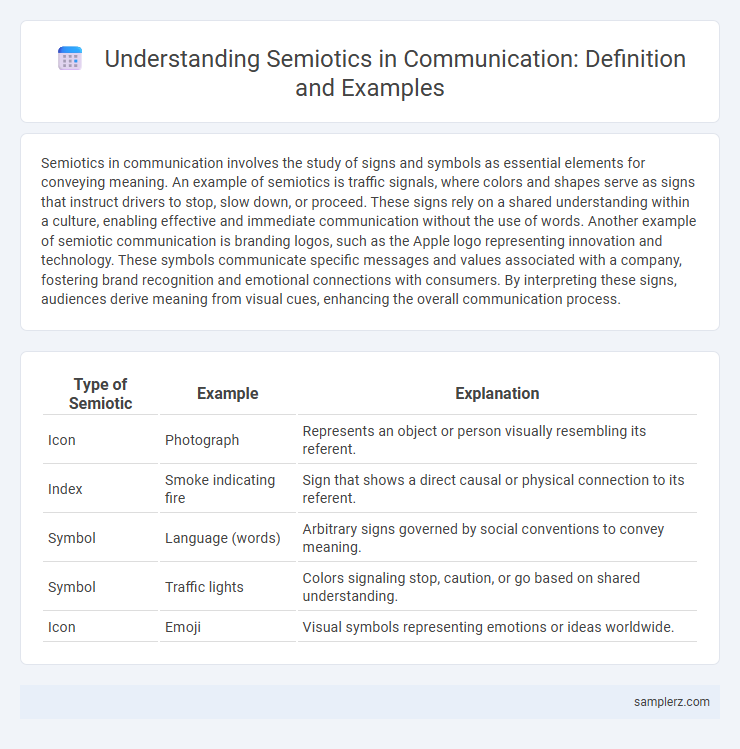Semiotics in communication involves the study of signs and symbols as essential elements for conveying meaning. An example of semiotics is traffic signals, where colors and shapes serve as signs that instruct drivers to stop, slow down, or proceed. These signs rely on a shared understanding within a culture, enabling effective and immediate communication without the use of words. Another example of semiotic communication is branding logos, such as the Apple logo representing innovation and technology. These symbols communicate specific messages and values associated with a company, fostering brand recognition and emotional connections with consumers. By interpreting these signs, audiences derive meaning from visual cues, enhancing the overall communication process.
Table of Comparison
| Type of Semiotic | Example | Explanation |
|---|---|---|
| Icon | Photograph | Represents an object or person visually resembling its referent. |
| Index | Smoke indicating fire | Sign that shows a direct causal or physical connection to its referent. |
| Symbol | Language (words) | Arbitrary signs governed by social conventions to convey meaning. |
| Symbol | Traffic lights | Colors signaling stop, caution, or go based on shared understanding. |
| Icon | Emoji | Visual symbols representing emotions or ideas worldwide. |
Understanding Semiotics in Communication
Semiotics in communication involves the study of signs and symbols as fundamental elements conveying meaning. For example, traffic lights use color-coded signals--red for stop, green for go, and yellow for caution--to nonverbally communicate instructions efficiently. Understanding semiotics enables clearer interpretation of messages by recognizing how signs function within cultural and contextual frameworks.
The Role of Signs and Symbols
Signs and symbols function as fundamental elements in communication by conveying meaning beyond words, enabling individuals to interpret messages through shared cultural or contextual understanding. For example, traffic lights use color-coded signals--red, yellow, and green--to nonverbally communicate stop, caution, and go, respectively, demonstrating how semiotics facilitates effective information exchange. The study of these signs and symbols reveals the intricate relationship between language, perception, and social interaction in the communication process.
Iconic Signs: Visual Representation in Messaging
Iconic signs in communication use visual representations that closely resemble the objects or concepts they signify, making messages immediately recognizable and easily understood. Examples include emojis, pictograms, and traffic signs, which convey meaning through imagery rather than words. These visual signs enhance clarity and speed of comprehension in digital messaging and public information systems.
Indexical Signs: Triggers and Associations
Indexical signs in communication function as direct indicators linking a sign to its object, such as smoke signaling fire or a clock showing time. These signs rely on a cause-and-effect or physical connection, triggering automatic associations that enhance message clarity and context understanding. For example, a siren's wail indexically signifies an emergency, prompting immediate attention and response in receivers.
Symbolic Signs: Cultural Codes in Language
Symbolic signs in communication, such as words and gestures, rely heavily on cultural codes that give them meaning within specific societies. For instance, the color white symbolizes purity in Western cultures but signifies mourning in some Eastern cultures, demonstrating how cultural context shapes interpretation. Understanding these cultural codes is essential for effective communication across diverse groups, preventing misinterpretations and enhancing message clarity.
Nonverbal Semiotics: Gestures and Body Language
Nonverbal semiotics in communication involves interpreting gestures and body language as signs conveying meaning without spoken words. For example, crossed arms often signify defensiveness or resistance, while maintaining eye contact typically indicates attention and confidence. Understanding these nonverbal cues enhances interpersonal communication by providing insight into emotions and intentions beyond verbal messages.
Semiotics in Digital Communication
Semiotics in digital communication involves the study of signs and symbols such as emojis, hashtags, and memes that convey meaning beyond words. These digital icons function as visual signs to express emotions, cultural references, and social cues instantly across platforms like social media and messaging apps. Understanding the semiotic codes behind these symbols enhances message clarity and engagement in virtual interactions.
Branding and Marketing: Semiotics in Advertising
Semiotics in advertising leverages symbols, colors, and signs to create powerful brand associations that influence consumer perception and behavior. Iconic logos, such as Apple's apple or Nike's swoosh, serve as semiotic tools that convey values like innovation or athleticism without words. Effective branding harnesses these semiotic elements to communicate identity, build emotional connections, and differentiate products in competitive markets.
Semiotics in Media and Popular Culture
Semiotics in media and popular culture is evident through the use of symbols, signs, and codes to convey messages and meaning, such as the iconic superhero costumes that signify identity and moral values. Advertising employs semiotic elements like color and imagery to evoke emotional responses and influence consumer behavior. Film and television narratives utilize visual and auditory signs to construct cultural myths and social ideologies, shaping audience perceptions and interpretations.
Enhancing Communication Through Semiotic Awareness
Understanding semiotic elements such as signs, symbols, and gestures significantly enhances communication by enabling more precise interpretation of messages. For example, recognizing cultural symbols and nonverbal cues helps avoid misunderstandings and fosters clearer interpersonal connections. Semiotic awareness empowers communicators to decode complex meanings beyond words, improving overall message effectiveness.

example of semiotic in communication Infographic
 samplerz.com
samplerz.com